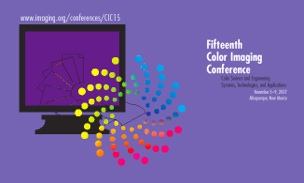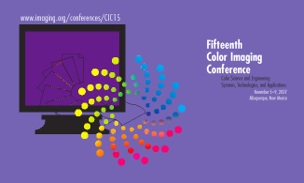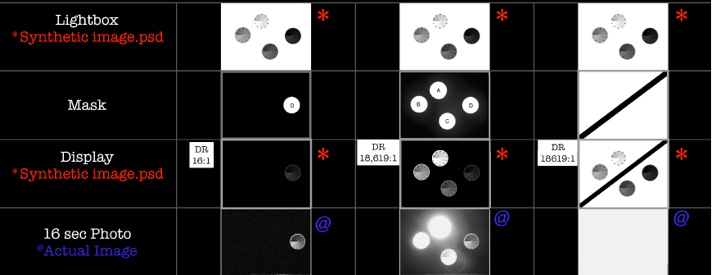Veiling Glare and HDR Imaging

Scientific Meetings and Papers:

2008 Google, Jan 25, Mountain View, CA
<http://youtube.com/watch?v=ALfiTDYLtAQ&feature=user>

John J. McCann and Alessandro Rizzi,
“Retinal HDR Images: Intraocular Glare and Object Size”
Proceedings of the Color Imaging Conference, Portland, CIC16, 24, 2008.
Starting from measured scene luminances, we calculated the retinal luminance images of High Dynamic Range (HDR) test targets. These test displays contain 40 gray squares with a 50% average surround. In order to approximate a natural scene the surround area was made up of half-white and half-black squares of different sizes. In this way, the spatial-frequency distribution approximates a 1/f function of energy vs. spatial frequency. We compared images with 2.7 and 5.4 optical density ranges. Although the target luminances are very different, after computing the retinal image according to the CIE scatter glare formula, we have found that the retinal luminance ranges are very similar. Intraocular glare strongly restricts the range of the retinal image. Further, uniform, equiluminant target patches are spatially transformed to different gradients with unequal retinal luminances. The usable dynamic range of the display correlates with the range of retinal luminances. Observers report that appearances of white and black squares are constant and uniform, despite the fact that the retinal stimuli are variable and non-uniform. Human vision uses complex spatial processing to calculate appearance from retinal luminance arrays. Our spatial image processing increases apparent contrast with increased white area in the surround. Spatial vision counteracts glare. The spatial contrast mechanism is much more powerful when compared with retinal, rather than with target luminances. This study adds additional evidence that human vision uses spatial image processing to synthesize appearance, rather than using the array of independent retinal responses.

A. Rizzi & J. J. McCann, “Simultaneous Contrast and Intraocular Glare:
Opposing Image Dependent Mechanisms in Appearance”, 2008.
J. J. McCann, “Color Matches in Dim Narrow-band Illumination”, 2008.

2008 CGIV Terrassa, Spain
J. J. McCann & A. Rizzi, “Appearance of High-Dynamic Range Images in a Uniform
.Lightness Space”, pp. 177-181, 2008.

2008 Electronic Imaging, San Jose
A. Rizzi, M. Pezzetti, & J. J. McCann,
“Separating the effects of glare from simultaneous contrast in HDR images”, 6806-9
J. J. McCann,
“Perceptual rendering of HDR in painting and photography” 6806-30
J. J. McCann,
“Color gamuts in dim illumination” 6807-2


2007 CIC, Albuquerque, NM
J. J. McCann
“Colors in Dim Illumination and Candlelight”
A. Rizzi, M. Pezzetti, and J. J. McCann
“Glare-limited Appearances in HDR Images”

2007 CREATE, Bristol
J. J. McCann
“The Interaction of Art, Technology and Consumers in Pictures Making”

2007 ECVP, Arezzo
J. J. McCann
Rod – Lcone color matching in complex images
Rod and L-cone interactions generate color appearances. This paper measure these appearances in complex scenes above and below-M and S-cone thresholds. The test target was a ColorChecker viewed in tungsten light and 1 wax candle. Firelight is an ideal illuminant for Rod-Lcone color. The observers’ task was to adjust RGB digits in LCD computer display to match the appearance of the ColorChecker. With the tungsten illumination, above L-,M-,& S-cone thresholds, the L*a*b* values for the reflective ColorChecker and the emissive LCD were reasonably close. With 1 candle illumination, the below M- and S-cone threshold ColorChecker showed matches marked different in L*a*b* values. A 4-D color space is not required because all colors were matched to above cone threshold colors, sharing information with other color channels. The color appearances are not consistent with rods sharing S-channel alone, or M-channel alone. The colors are not consistent with the rods desaturating all three channels. Under these conditions, the colors are consistent with the rod spatial comparisons sharing both the M- and the S-cone channels.
A. Rizzi, M. Pezzetti, J.J. McCann,
Measuring the visible range of High Dynamic Range Images (HDRI)
We made pairs of identical film transparencies. We viewed one (single-contrast), then two superimposed in registration (double-contrast). Single-contrast images have 2.7 log 10 dynamic range; double contrast 5.4 log10 range. Observers estimated the appearance of 40 gray areas surrounded with various size white and black blocks. First, the surround had equal white and black areas (average single-contrast luminance=50.01%max) and (double-contrast=50.00%max). Doubling the contrast had minimal effect on retinal glare. Magnitude estimates show nearly the same plot (appearance vs. log luminance) for both contrasts in the range of 0.0 to 2.3OD, and no discrimination at higher optical densities. Second, with a (8%white&92% black) surround appearances covered 0.0 to 2.7. Increasing the stimulus range had little effect on appearance. Decreasing the surround’s white area, decreased veiling glare and increased the range of usable densities. These, and other experiments, measure how veiling glare controls the range of appearance in HDRI.

INVITED PAPERS
J. J. McCann, “Art Science and Appearance in HDR images”, J. Soc. Information Display, vol. 15(9), 709-719, 2007.
J. J. McCann and A. Rizzi, (2007) “Camera and visual veiling glare in HDR images”, J. Soc. Information Display, vol. 15(9), 721-730, 2007.

2007 IMQA, Chiba
J. J. McCann, A. Rizzi,
“Spatial Comparisons:
The Antidote to Veiling Glare Limitations in Image Capture and Display”
2007 IMQA Lecture, Chiba
Large .pdf file = 43 MB

Color Imaging Conference, November 7-9, 2007,
Albuquerque, NM
Glare-limited Appearances in HDR Images
A. Rizzi, M. Pezzetti, and J. J. McCann
Dip. Tecnologie dell’Informazione, Università degli Studi di Milano, Italy,
McCann Imaging, Belmont, MA, USA
Appearance in High Dynamic Range (HDR) images is controlled by intraocular glare and simultaneous contrast. This paper describes unique test targets that simulate real images. They change the HDR range by 500 times without significantly changing the veiling glare on the retina. As well, these targets have nearly constant simultaneous contrast. Using these test targets we measured the range of appearances possible from HDR images with different average luminances. The targets displayed a maximum luminance range of 5.4 log units. However, the results show that the usable range of luminances for a full range of appearances (white to black) is much smaller.
ECVP , August 27-30, 2007,
European Conference on Visual Perception, Arezzo, Italy
Intraocular glare controls the visible range of High Dynamic Range Images (HDRI)
A. Rizzi, M. Pezzetti, J.J. McCann,
Measuring the visible range of High Dynamic Range Images (HDRI)
We made pairs of identical film transparencies. We viewed one (single-contrast), then two superimposed in registration (double-contrast). Single-contrast images have 2.7 log 10 dynamic range; double contrast 5.4 log10 range. Observers estimated the appearance of 40 gray areas surrounded with various size white and black blocks. First, the surround had equal white and black areas (average single-contrast luminance=50.01%max) and (double-contrast=50.00%max). Doubling the contrast had minimal effect on retinal glare. Magnitude estimates show nearly the same plot (appearance vs. log luminance) for both contrasts in the range of 0.0 to 2.3OD, and no discrimination at higher optical densities. Second, with a (8%white&92% black) surround appearances covered 0.0 to 2.7. Increasing the stimulus range had little effect on appearance. Decreasing the surround’s white area, decreased veiling glare and increased the range of usable densities. These, and other experiments, measure how veiling glare controls the range of appearance in HDRI.
Art Science and Appearance in HDR images,
J. J. McCann,
J. Soc. Information Display, vol. 15(9), in press. 2007.
High Dynamic Range (HDR) image capture and display has become an important engineering topic. The discipline of reproducing scenes with a high range of luminances has a five -century history that includes painting, photography, electronic imaging and image processing. HDR images are superior to conventional images. There are two fundamental scientific issues that
control HDR image capture and reproduction. The first is the range of information that can be measured using different techniques. The second is the range of image information that can be utilized by humans. Optical veiling glare severely limits the range of luminance that can be captured and seen. It is the improved quantization of digital data and the preservation of the
scene’s spatial information that causes the improvement in quality in HDR reproductions.
Camera and visual veiling glare in HDR images,
J. J. McCann and A. Rizzi,
J. Soc. Information Display, vol. 15(9), in press, 2007.
High-dynamic-range (HDR) images are superior to conventional images. The experiments in this paper measure camera and human responses to calibrated
HDR test targets. We calibrated a 4.3-log-unit test a target, with minimal and maximal glare from changeable surround. Glare is an uncontrolled spread of an image-dependent fraction of scene luminance in cameras and in the eye. We use this standard test target to measure the range of luminances that can be captured on a camera’s image plane. Further, we measure the appearance of these test luminance patches. We discuss why HDR is better than conventional imaging, despite the fact the reproduction of luminance is inaccurate.
IMQA, March 8-9, 2007,
The Second Int. Workshop on Image Media Quality and its Applications, Chiba, Japan
“Spatial Comparisons:
The Antidote to Veiling Glare Limitations in Image Capture and Display”
John J. McCann (McCann Imaging, Belmont, MA 02478),
Alessandro Rizzi (Dip. Tecnologie dell’Informazione, Università degli Studi di Milano, Italy),
Many labs are studying High Dynamic Range (HDR) image capture and display. In digital imaging, the popular multiple exposures technique attempts to extend cameras’ range in recording darker scene regions. This paper describes the long history of HDR imaging from Renaissance paintings to modern digital imaging. It as reviews experiments that measure camera and human responses to calibrated HDR test targets. It describes measurements showing that image dynamic range is limited by the camera’s veiling glare. Glare is an uncontrolled spread of an image-dependent fraction of scene luminance caused by unwanted scattered light in the camera and in the eye. The paper describes measurements of the physical limits of veiling glare and evaluates the role of accurate reproduction of luminance in imaging. The paper discusses why HDR imaging are better than conventional imaging, despite the fact the reproduction of luminance is inaccurate.
2007 IS&T/SPIE Electronic Imaging, San Jose, CA
EI 6492-41
Veiling Glare: The Dynamic Range Limit of HDR Images
John J. McCann (McCann Imaging, Belmont, MA 02478),
Alessandro Rizzi (Dip. Tecnologie dell’Informazione, Università degli Studi di Milano, Italy),
High Dynamic Range (HDR) images are superior to conventional images. However, veiling glare is a physical limit to HDR image acquisition and display. We performed camera calibration experiments using a single test target with 40 luminance patches covering a luminance range of 18,619:1. Veiling glare is a scene-dependent physical limit of the camera and the lens. Multiple exposures cannot accurately reconstruct scene luminances beyond the veiling glare limit. Human observer experiments, using the same targets, showed that image-dependent intraocular scatter changes identical display luminances into different retinal luminances. Vision’s contrast mechanism further distorts any correlation of scene luminance and appearance.
There must be reasons, other than accurate luminance, that explains the improvement in HDR images. The multiple exposure technique significantly improves digital quantization. The improved quantization allows displays to present better spatial information to humans. When human vision looks at high-dynamic range displays, it processes them using spatial comparisons.
Late Breaking News
2006 Color Imaging Conference -Scottsdale, AZ
There are two different veiling glare mechanisms that limit the dynamic range of images that can be captured from real scenes in the world and displayed to humans. Veiling glare is the light scattered by camera lenses and cameras, or the human lens and ocular media.
2006 ADEAC (SID/VESA) Invited Paper
J. J. McCann and A. Rizzi,
“Optical veiling glare limitations to in-camera scene radiance measurements”,
in Proc ADEAC (SID/VESA), 3rd Americas Display Eng. & App. Conference, Atlanta, p. 51, 2006
Veiling glare is a physical limit to HDR image acquisition. Multiple exposures improve quantization, but cannot overcome the glare limit to dynamic range. Human visual optics have much greater glare than cameras, yet outperforms conventional photography in recording details in shadows. This paper measures glare limits in HDR test targets and reviews display algorithms that mimic human vision to get better HDR performance.
2006 ECVP
European Conference of Visual Perception - St. Petersburg, Russia
J. J. McCann and A. Rizzi,
“Optical veiling glare limitations to in-camera scene radiance measurements”,
in ECVP 2006 Abstracts, Perception, 35, Supplement, p. 51, 2006.
Multiple exposure techniques improve the quantization of pixel values in digital images and are claimed to extend the dynamic range of captured radiances. The combination of underexposed, normal and overexposed images quantizes more accurately images falling on the sensor. However, scene-image dynamic range on that sensor is controlled by veiling glare of the lens, light reflected inside the camera body, and light reflected off the sensor. The point spread function of all cameras falls off very quickly with distance. This rapid decrease is offset by the millions of image pixels contributing small, but significant glare to all other pixels. We made telephotometer measurements from test scenes to accurately document the radiances in scenes. We used a variety of High Dynamic Range (HDR) calibration algorithms and evaluated their accuracy. In the worst-case scene, with a small opaque center and a large-high-radiance surround, (ISO 9358:1994 standard for Veiling Glare measurements), camera veiling glare limits are reported to vary from 1% to 8% of the maximum radiance. That is, a film(sensor)-plane image dynamic range of only ~25:1. Presented data shows that veiling glare is an image-dependent limit to in-camera radiance measurement of real-life scenes and must be considered in HDR natural images.
1983 JOSA
W. A. Stiehl, J. J. McCann and R. L. Savoy,
“Influence of intraocular scattered light on lightness-scaling experiments”,
J. opt. Soc. Am., 73, p. 1143-1148, 1983.
History of HDR Imaging in Pictures

What is the dynamic range of High Dynamic Range Imaging (HDR)?
There is considerable recent interest in combining different camera exposures to make a synthetic image representing a scene.
The idea is that by exposing for longer times, the dark areas of the scene will be recoded even though the high-luminance areas are over exposed. HDR techniques improve images in which the scene range is greater than the cameras range.
The use of multiple exposures to capture HDR scenes has a long and interesting history.
<http://youtube.com/watch?v=ALfiTDYLtAQ&feature=user>
“Art Science and Reality of High Dynamic Range (HDR) imaging”
“Art Science and Appearance in HDR images”
“The Interaction of Art, Technology and Consumers in Pictures Making”
“Perceptual rendering of HDR in painting and photography”
The actual dynamic range that can be recorded depends on the content of the image.
The veiling glare of optical system controls dynamic range of the image in the camera.
“Optical veiling glare limitations to in-camera scene radiance measurements”
“Intraocular glare controls the visible range of High Dynamic Range Images (HDRI)”
“Optical veiling glare limitations to in-camera scene radiance measurements”
“Late Breaking News-2006 Color Imaging Conference”
“Veiling glare: the dynamic range limit of HDR images”
“Camera and visual veiling glare in HDR images”
“Spatial Comparisons:The Antidote to Veiling Glare Limitations in Image Capture and Display”
-
A.Rizzi, and J. J. McCann, Glare-limited appearances in HDR images, J. Soc. Info. Display 17 (1) pp. 3-12, 2009.
-
J.J. McCann, and A. Rizzi, Retinal HDR images: Intraocular glare and object size, J. Soc. Info. Display 17 (11), pp. 913-920, 2009.
Intraocular scattered light also limits the range of light on the retina. As with cameras, the range depends on the content of the target image. The following experiments measured the range of usable display dynamic range with different scenes. There is also recent interest in multi-technology HDR imaging displays.
“Influence of intraocular scattered light on lightness-scaling experiments”
“Measuring the visible range of High Dynamic Range Images (HDRI)”
“Simultaneous Contrast and Intraocular Glare:Opposing Image Dependent Mechanisms in Appearance”
“Glare-limited Appearances in HDR Images”
This paper compares the range of appearance vs. the range of calculated luminances on the retina.
“Retinal HDR Images: Intraocular Glare and Object Size”
Nevertheless, HDR images are far superior to conventional images. The reason is that HDR images preservers edge information in the scene, and reproduces these edges the print or display.
“Rendering High-Dynamic Range Images: Algorithms that mimic Vision”
“Art Science and Appearance in HDR images”
“On the Behavior of Spatial Models of Color”
“Appearance of HDR Images in a Uniform Lightness Space”